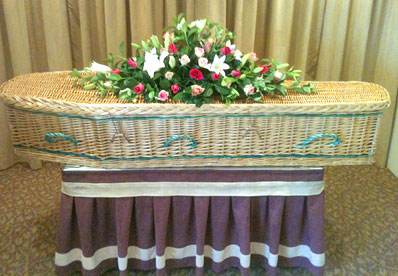Eco Friendly Hand Woven Caskets
Willow grows from February to July and in the right conditions it can grow inches per day. It is traditionally planted closely spaced which forces the wicker rods to grow straight and tall. It produces generous foliage during the growing season.
From July to November wicker stops growing and gradually sheds it's foliage. Between late November and February willow becomes dormant and this is the season for harvesting and for planting new cuttings for next year.
Willow plants are grown sustainably being very easy to harvest and requiring no fertilisers, pesticides or herbicides. The plants can replenish fertility in degraded and marginal soils and also provide habitat for birds and insects.
They also act as windbreaks, stabilise soil and can combat river and coastal erosion. It also provides badly needed seasonal income for families in farming communities.
Willow coffins are among the most environmentally friendly coffins available. We believe that our coffins are the ultimate in environmental recycling as willow is a highly renewable crop harvested each year which involves minimal processing.
It can degrade rapidly in the soil and helps to lock carbon emissions into its willow stems.
In the right soil conditions willow tends to decompose much more quickly than traditional materials such as MDF, hardwoods and metal.
Willow is a carbon neutral material and when burnt only gives off the same amount of carbon that it consumes within it's lifetime.
Nearly half a million wooden coffins are burnt in the UK each year, polluting the atmosphere with dioxin, hydrochloric acid, hydrofluoric acid, sulphur dioxide and carbon dioxide. These same toxins are released during decomposition, just more slowly from underground and are released into the soil first.
All of our Willow Caskets are completely natural and biodegradable. They break down in 6 months to 2 years depending on soil conditions. Willow coffins are woven and therefore do not depend on toxic glues, varnish, plastics, or metals.
Their colours are the natural plant dyes in the pigmentation. This means that colour tone may vary from batch to batch.
Because our caskets are packed and shipped inside each other like Russian dolls they also have a very small carbon footprint when transported.
Eco friendly caskets are a beautiful and natural solution to a difficult problem.

Planting the willow by hand

Willow in full bloom

Harvesting the willow by hand
The History Of Willow & Wicker
Willow was sacred to ancient cultures and was often used as a funerary herb. Druidic sacrifices were made at the full moon in willow baskets and funerary flints were made in a willow shape. Ancient burial mounds situated near to water were often lined with willow.
Willow has long been used to ward off evil, for protection and to overcome the fear of death. For safe life in another life, it was customary to plant a willow during one's lifetime so that its life would continue after ones death. It is a tree of death and rebirth. The ancient Egyptians used willow for many products including furniture and baskets.
Willow and wicker is mentioned many times in the bible from the story of Moses to Psalm 137:
By the rivers of Babylon, there we sat down, yea, we wept, when we remembered Zion.
We hanged our harps upon the willows in the midst thereof.
Wicker coffins are also not a new idea as Sir Frances Haden developed them in the late 19th century. His design had no lid and was to be filled with flowers or earth for natural burial.


